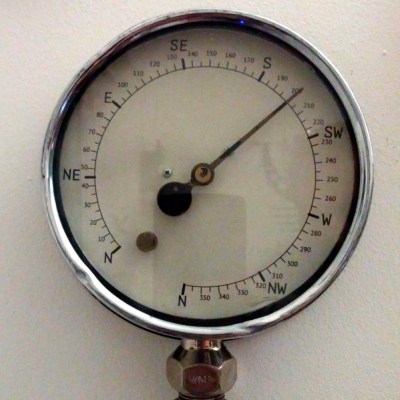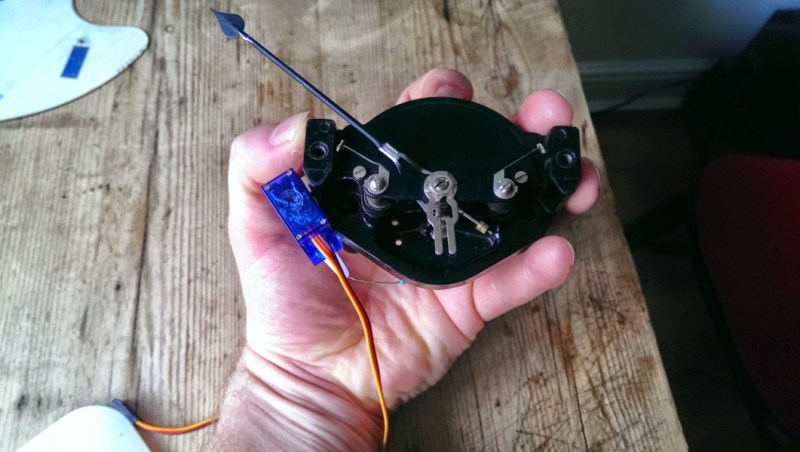When your passion is a sport that depends on Mother Nature’s cooperation, you need to keep a close eye on weather conditions. With this in mind, and not one to let work distract him from an opportunity to play, [mechanicalsquid] decided to build a wind-monitoring gauge with an old-school look to let him know when the wind is right for kitesurfing.
 Being an aficionado of big engineering helped [mechanicalsquid] come up with a style for his gauge – big old dials and meters. We hesitate to apply the “steampunk” label to every project that retasks old technology, but it sure looks like a couple of the gauges he used could have been for steam, so the moniker probably fits here. Weather data for favorite kitesurfing and windsurfing locales is scraped from the web and applied to the gauges to indicates wind speed and direction. [mechanicalsquid] made a valiant effort to drive the voltmeter coil directly from the Raspberry Pi, but it was not to be. Servos proved inaccurate, so steppers do the job of moving the needles on both gauges. Check out the nicely detailed build log for this one, too.
Being an aficionado of big engineering helped [mechanicalsquid] come up with a style for his gauge – big old dials and meters. We hesitate to apply the “steampunk” label to every project that retasks old technology, but it sure looks like a couple of the gauges he used could have been for steam, so the moniker probably fits here. Weather data for favorite kitesurfing and windsurfing locales is scraped from the web and applied to the gauges to indicates wind speed and direction. [mechanicalsquid] made a valiant effort to drive the voltmeter coil directly from the Raspberry Pi, but it was not to be. Servos proved inaccurate, so steppers do the job of moving the needles on both gauges. Check out the nicely detailed build log for this one, too.
For more weather station fun be sure to check out this meter-based weather station with a slightly more modern look. And for another build in the steampunk style, this vintage meter and Nixie power display is sure to impress.
















I like this! I’ve been thinking how to display my local wind and wave conditions with something a little cooler than a web page, but haven’t gotten farther than a glass float that lights up when my favorite conditions are met.
The 360 degrees displayed over ~320 degrees makes my brain hurt a little, but I understand that for a particular site, the exact direction can make a big difference. Our spot is quite different in a NE vs a ENE wind.
So how are you going to monitor waves remotely, that’s going to be hard.
I used to deploy underwater wave sensors for UH, but these days I just check the NOAA automated buoy reports. They’re pretty thorough, and easy enough to scrape. I could just check a web page, but I wanted a physical reminder that it’s time to put down the tools and go for a kite.
As @wade says, surfers have been checking the NOAA reports (and forecasts) for ages. I used to have a neural network that would decide Black’s versus Del Mar depending on wave height and direction. Ah, wasted youth!
This is very cool and I’m saving it for future reference, but without being overly critical it illustrates how you can get into a corner with a project.
The original gauges didn’t rotate 360° and after a lot of trials the mechanism was replaced by an accurate stepping motor that also didn’t rotate 360°, and a dial was printed to accommodate that giving an accurate, usable but unintuitive display. Why accept the limitation?
Most stepping motors do nothing but rotate continuously, including those that can or are geared down for much more positional resolution (pillage your nearest inkjet/laser printer for an example). The only challenge would be to “zero” it occasionally (or to have a position encoder – again, many cheap inkjet printers have parts that can be used).
Why bother? The first time you see that pointer go completely and accurately around the dial and beyond, based on web data would be geek joy.
Yes it would be
Yes, you’re right. Its completely feasable to go a full 360.
But the physical hardware, electronics and software won’t do it without significant modification or replacement.
Directly copying the other gauges is an easy way to a solution, at the expense of no 360 rotation.
Maybe something for a future modification, but for now I’m happy.
A small stepper motor and a photo gate would make this very easy to do, with the additional benefit of being completely silent / no power while stationary.
Cool
So you are saying I don’t need a weatherman…. ?
I knew someone would get it. Glad it was you, Al.
What happens when the wind is from the north and of course varies it’s vector? I had an antenna rotor that stopped at north, I modded it to use east as the point of return. I can get nothing to the east but Chicago and Elkhart are NNW and NNE, now close together. This holds fairly true for wind in the northern hemisphere. When Canada’s calling it’s nice to see it in one place. Here in Indiana it’s only a handful of counties and water straight north to big goose land. America has a north coast complete with big dunes.
But does it let you know…
Any way the wind blows?
Why is is east where west should be? Or visa versa… cool project though, want to do something similar with my hot water tank level remotlely :)